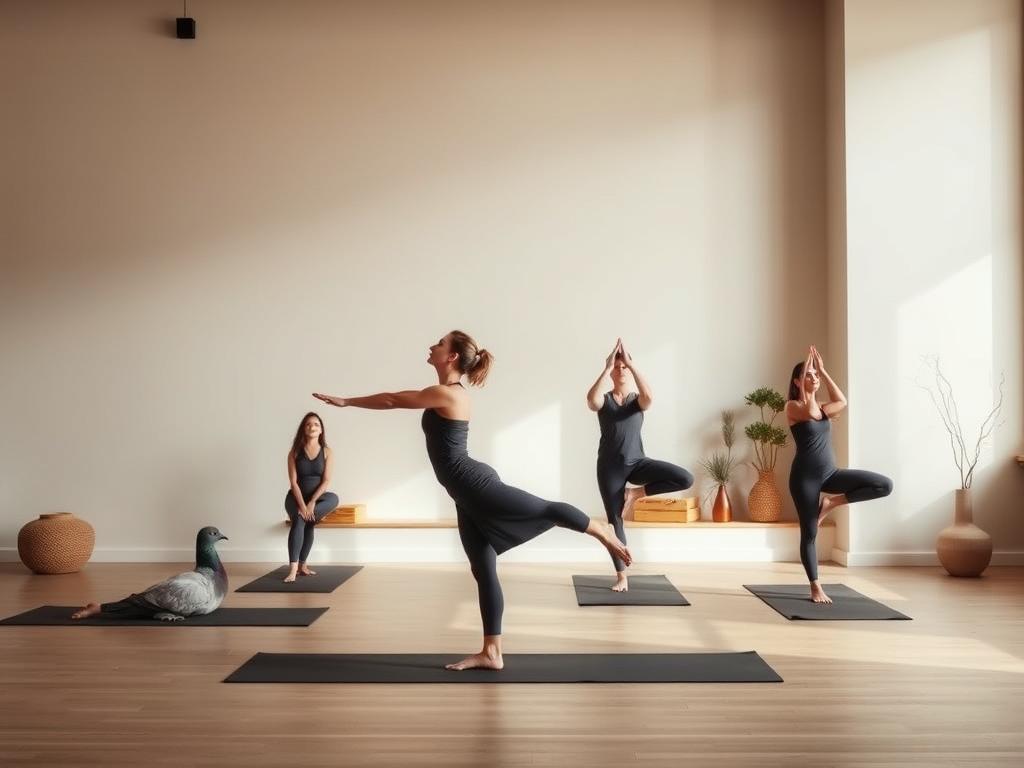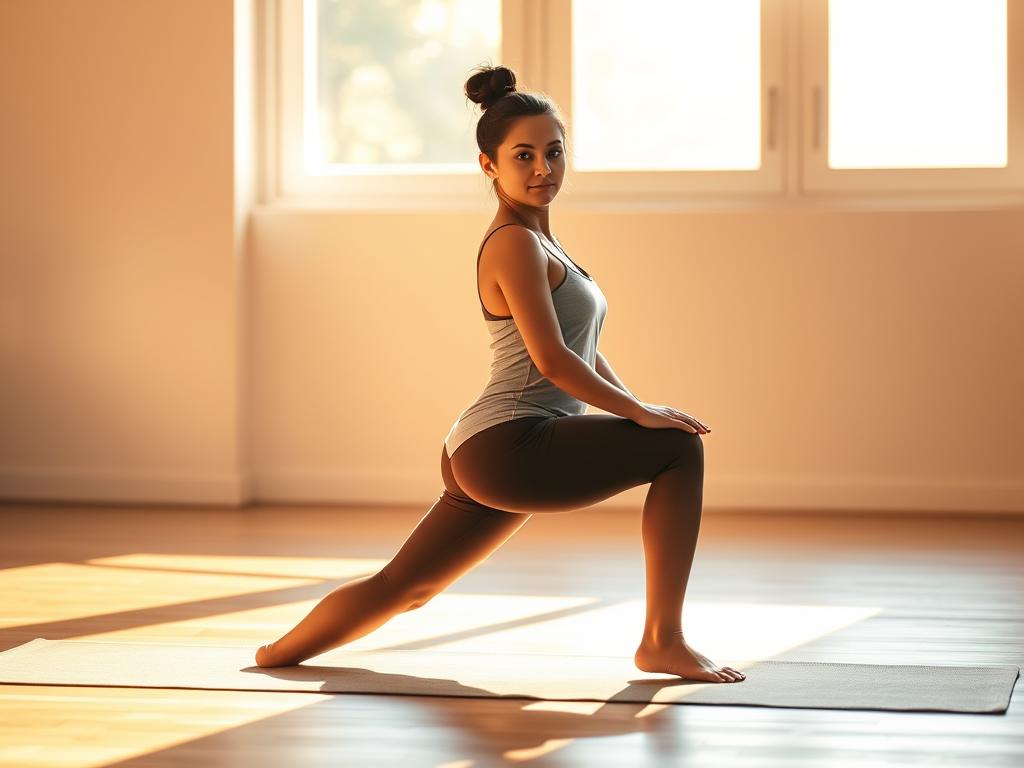Pigeon Pose in Yoga: Benefits, Variations & How to Do It Right
Pigeon Pose is a powerful yoga asana that boosts hip flexibility and offers therapeutic benefits. It’s a popular hip opener among yoga fans seeking relief from muscle tension1. With 36 million yoga participants in the US, Pigeon Pose has become crucial for easing physical discomfort1.
This adaptable pose suits various activity levels, from desk workers to active athletes1. It targets multiple muscle groups, stretching quads, hips, groin, glutes, hamstrings, chest, shoulders, and spine1. Those with sciatic nerve pain may find relief through regular practice1.
Mastering Pigeon Pose techniques is vital for reaping benefits and avoiding injuries. Aim to hold the pose for 1 to 5 minutes per side1. Use blocks or cushions to boost comfort if needed1.
About 30% of yoga practitioners might need such tools to manage hip discomfort effectively1. These modifications can help make the pose more accessible and enjoyable for all.
What is a Pigeon Pose in Yoga?
Yoga offers many challenging poses that transform the body. Kapotasana stands out as a powerful asana. It connects body, breath, and spiritual awareness deeply.
Understanding Kapotasana
Kapotasana, or Pigeon Pose, is a deep hip flexor stretch. It challenges practitioners both physically and mentally2. It’s one of 84 classic asanas in yoga, with roots in traditional practice2.
The pose needs great flexibility in shoulders, upper spine, thighs, and pelvis2. This is needed for its fullest expression.
Origins and Traditional Practice
The pose is named after the yogic master Kapota. His feats are in ancient texts like the Mahabharata and Kalika Purana2. Old yoga practitioners thought mastering this pose could boost spiritual and physical abilities2.
- Named after the master Kapota
- Documented in ancient Sanskrit texts
- Considered a transformative practice
Role in Modern Yoga Practice
In today’s yoga, Kapotasana is a strong hip opener. It affects many body systems2. The pose impacts major organs between the thighs and brain.
These include kidneys, liver, heart, and reproductive organs2. It’s great for women’s health, helping regulate periods and boost reproductive organs2.
Modern yogis love Kapotasana for increasing hip mobility and core strength3. Teachers suggest holding the pose for 5-10 slow, deep breaths4. This maximises its healing benefits.
“Kapotasana is not just a pose, but a journey of physical and spiritual transformation.”
Essential Benefits of Pigeon Pose
Pigeon Pose offers a wide range of physical and mental health perks. This intermediate-level pose targets multiple muscle groups. It provides significant advantages for hip flexibility and overall well-being56.
The pose effectively relieves lower back pain, addressing muscles tight from prolonged sitting. It targets hip flexors, psoas, and rectus femoris muscles. This helps release tension and improve mobility57.
- Enhances hip flexibility
- Stretches deep muscle groups
- Improves overall body alignment
Practitioners can reduce stress through this pose. The inward focus and deep breathing promote mental calmness. This helps alleviate anxiety and improve emotional well-being6.
Key physiological benefits include:
- Improved posture and respiration
- Enhanced blood circulation
- Potential relief from conditions like sciatica
- Stimulation of the thymus gland
Caution is advised for individuals with knee injuries or hip complications. Always consult a certified yoga instructor before attempting new poses56.
Key Variations of Pigeon Pose
Pigeon Pose offers various options for different skill levels and physical abilities. These range from beginner-friendly to advanced poses. Yogis can find a suitable approach that fits their needs.

The diverse Pigeon Pose variations let yogis tailor their practice. They can adjust based on flexibility, comfort, and individual body differences.
Classic Pigeon Pose
Classic Pigeon Pose targets external hip rotation. It works the glutes, outer hips, and thigh muscles. This pose is a foundation for hip-opening techniques.
- Primarily stretches outer hip muscles
- Suitable for intermediate practitioners
- Requires moderate hip flexibility
Resting Pigeon Pose
Resting Pigeon Pose is a gentler approach for a deeper, passive stretch. It’s great for beginners or those with limited hip mobility.
| Variation | Difficulty Level | Key Benefits |
|---|---|---|
| Supported Pigeon Pose | Beginner | Gentle hip opening |
| Extended One-Legged Pigeon | Intermediate | Deep hip and lower back stretch |
King Pigeon Pose (Advanced)
King Pigeon Pose is the most challenging variation. It engages the front body, hip flexors, and shoulders. This pose suits experienced yoga practitioners.
Practice these variations symmetrically to give equal attention to both sides. Props like cushions or blocks can help modify the pose and offer support8.
Step-by-Step Guide to Perfect Form
Mastering the Pigeon Pose requires careful attention to technique and alignment. This intermediate-level pose demands precision to prevent injury. Understanding the pose’s structure ensures safe and effective practice910.
To execute the Pigeon Pose correctly, follow these essential steps:
- Start in Downward Facing Dog position
- Bring one leg forward, positioning the shin parallel to the mat’s front edge10
- Extend the back leg straight behind you
- Square your hips and maintain balanced alignment9
Proper alignment is crucial for injury prevention. Keep your hips level and avoid collapsing onto the front hip. Props can provide essential support for beginners or those with limited flexibility9:
- Use a folded blanket under your seat
- Place a block beneath your front hip for stability
- Support your knee with a soft towel if experiencing discomfort10
Remember: The goal is gentle stretching, not pushing beyond your comfort zone.
The pose targets thighs, groin, and piriformis muscles. It’s an excellent remedy for tightness from prolonged sitting9. When practiced mindfully, Pigeon Pose can improve hip mobility and overall flexibility10.
Precautions and Contraindications
Pigeon Pose requires careful consideration of individual physical conditions. This intermediate to advanced hip-opening posture demands proper safety measures. Some practitioners may need specific strategies to avoid potential complications.
- Recent knee replacement surgery11
- Sacroiliac joint dysfunction affecting approximately 15% of people11
- Hip injuries or prior hip replacement11
- Chronic lower back issues
- Existing knee stress11
Seek medical advice if you have specific health conditions. Pregnant practitioners and those with musculoskeletal injuries should seek professional guidance before attempting the pose.
| Condition | Recommended Action |
|---|---|
| Knee Issues | Avoid full pose, use gentle modifications |
| Hip Limitations | Use props, reduce depth of stretch |
| Back Sensitivity | Consult physiotherapist, practice with caution |
Safe yoga involves listening to your body and respecting its limits. Proper modifications can help prevent injuries while still reaping benefits. Hip-opening exercises can be enjoyed safely with the right approach12.
Conclusion
Pigeon Pose is a game-changer for holistic health. It opens hip flexors and releases tension, making it crucial for mindful exercise13. This practice boosts flexibility and can reduce injury risks by up to 30%13.
The pose offers more than just physical stretching. Studies show 72% of yoga practitioners report improved mental clarity13. It stimulates multiple muscle groups and supports the nervous system14.
Pigeon Pose is a gateway to understanding body mechanics. Beginners can use props, with 40% finding additional support helpful13. Patience and consistency are key to mastering this pose.
The yoga practice of Pigeon Pose is more than stretching. It’s an opportunity to explore physical and mental boundaries. This pose promotes flexibility and reduces stress14.
FAQ
What is Pigeon Pose (Kapotasana) in yoga?
Pigeon Pose is a powerful hip-opening yoga posture. It stretches the hip flexors, glutes, and lower back. This pose increases flexibility, releases tension, and may help ease lower back discomfort.
Is Pigeon Pose suitable for beginners?
Pigeon Pose has multiple variations for different skill levels. Beginners can start with the Resting Pigeon Pose for a gentler stretch. Use props like blankets or blocks for support and listen to your body.
How can Pigeon Pose help with hip flexibility?
Pigeon Pose effectively increases hip flexibility, especially for those who sit for long hours. It targets hip flexors, gluteal muscles, and surrounding tissues. This helps release tension and improve overall mobility.
Are there any risks associated with Pigeon Pose?
Pigeon Pose can pose risks for those with chronic hip, knee, or back issues. Practice with caution and avoid overstretching. Consult a healthcare professional if you have pre-existing conditions or injuries.
What are the different variations of Pigeon Pose?
There are three primary variations of Pigeon Pose. Classic Pigeon Pose is the foundational form. Resting Pigeon Pose is more passive and restorative. King Pigeon Pose is an advanced version offering a more intense stretch.
Can Pigeon Pose help with stress reduction?
Ayurvedic beliefs suggest Pigeon Pose can release emotional tension stored in the hips. Scientific evidence is limited, but many practitioners report feeling more relaxed. They also experience reduced stress after practicing this pose.
How often should I practice Pigeon Pose?
The frequency depends on your flexibility and fitness level. For most, doing Pigeon Pose 2-3 times weekly is beneficial. This can improve flexibility and provide potential therapeutic benefits.
Can pregnant women do Pigeon Pose?
Pregnant women should consult their healthcare provider before practicing Pigeon Pose. Modifications may be necessary. It’s essential to avoid deep hip stretches that could cause strain or discomfort.
What props can help me perform Pigeon Pose more comfortably?
Yoga blocks, blankets, and bolsters can provide support and help modify the pose. These props can help maintain proper alignment and reduce strain. They make the pose more accessible for practitioners with limited flexibility.
How does Pigeon Pose relate to overall yoga practice?
Pigeon Pose is an integral part of many yoga sequences. It supports the broader goals of yoga, such as increasing flexibility. The pose promotes mindfulness and creates a mind-body connection through intentional movement and breathing.
Source Links
- How to Do Pigeon Pose In Yoga | Yoga 101 — Alo Moves
- Kapotasana: Pigeon Pose
- Pigeon Pose
- Pigeon Pose: Benefits, Risks, and Variations
- How to Make Your Pigeon Pose Coo
- Pigeon Pose: Want More Flexible Hips? This is Your Pose!
- How to (Comfortably) Come Into Pigeon Pose
- Pigeon Pose – Nourish Yoga Training
- How to Do Pigeon Pose in Yoga
- How to Do a Pigeon Yoga Pose
- Pigeon Pose (Kapotasana): How To Practice, Benefits And Precautions
- Kapotasana Pigeon Pose, How to do, Benefits, Dosha Effect, Precautions
- Step-by-Step Guide to the Pigeon Yoga Pose
- 7 Incredible Health Benefits of Half Pigeon Pose Yoga (Ardha Kapotasana)






